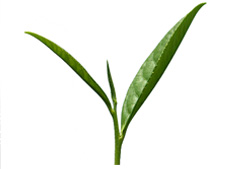







Green tea leaf
Epidemiologically, it is well known that the consumption of green tea may help to prevent cancers in humans and also to reduce several free radicals including peroxynitrite.
In a recent study to assess the efficacy of the inhibition of mushroom tyrosinase (monophenol monooxygenase EC 1.14.18.1), ten kinds of traditional Korean teas were screened for their tyrosinase inhibitory activity. Green tea was the strongest inhibitor, and its major active constituents are (-)-epicatechin 3-O-gallate (ECG), (-)-gallocatechin 3-O-gallate (GCG) and (-)- epigallocatechin 3-O-gallate (EGCG). All are catechins with a gallic acid group as an active site.
The kinetic analysis of the inhibition of tyrosinase revealed a competitive nature of GCG with this enzyme for Ltyrosine binding at the active site of tyrosinase.
Phenolic compounds from plant sources, particularly flavonoids, have long been observed to have antioxidant activity with potential benefits for human health. Epigallocatechin gallate (EGCG) is a principle phenolic antioxidant found in a variety of plants, including green and black tea.
>
>
>
>
>
>
>
>
>
>
>
>
>
>
>
>
>
>
>
>
>
>
>
>
>
>
>
>
>
>
>
>
>
>
>
>
>
>
>
>
>
>
>
>
>
>
>
>
>
>
>
TOP 20
Hydroquinone
Monobenzyl Ether of Hydroquinone
Azelaic Acid
Kojic Acid
Arbutin
Retinoids
Mequinol
Niacinamide
Soy
Vitamin C
Corticosteroids
Licorice
Hydroxystilbene
Aloesin
Glutathione
Glycolic Acid
N Acetyl Glucosamine
Gentisic Acid
Green Tea
Melatonin
SKIN WHITENING AGENTS A-Z
a-Hydroxyacids
Aloesin
Alpha Tocopherol and Alpha Tocopherol Ferulate
Arbutin
Azelaic Acid
Centaureidin and Methylophiopogonanone B
Gallic Acid and Derivatives
Gingko
Ginseng
Glutathione
Glycolic Acid
Green Tea
Hesperidin
Hydroquinone
Hydroxycinnamic Acid and Derivatives
Hydroxystilbene
Kojic Acid
Licorice
Linoleic Acid
Magnesium Ascorbyl Phosphate
Melatonin
Mequinol
Monobenzyl Ether of Hydroquinone
Mulberry
N Acetyl Glucosamine
N-Acetyl-4-S-Cysteminylphenol
Niacinamide
Retinoids
Salicylic Acid
Soy
Vitamin C

<< Previous: Gentisic Acid
Next: Melatonin >>